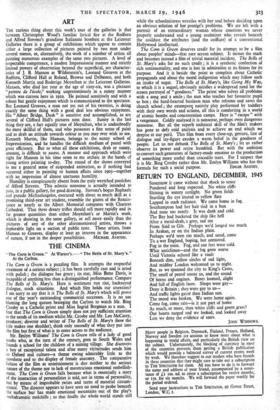ART
THE curious thing about this week's tour of the galleries is that between Christopher Wood's familiar lyrical fire at the Redfern
and Alfred Stevens's grandiose Italianate bombast at the Leicester Galleries there is a group of exhibitions which appear to contain either a large collection of pictures painted by two men under several names, or, alternatively, the work of a number of artists all painting numerous examples of the same two pictures. A level of respectable competence, a modest Impressionist manner and strictly
limited powers of observation beyond the superficial, are character- istics of J. B. Manson at Wildenstein's, Leonard Greaves at the Redfern, Clifford Hall at Roland, Browse and Delbanco, and both Kenneth Martin and Roderigo Moynihan at the Leicester Galleries. Manson, who died last year at the age of sixty-six, was a pleasant "peintre de l'ecole," working unpretentiously in a sunny manner which was current here in 191o. He painted sensitively and with a robust but gentle enjoyment which is communicated to the spectator. But Leonard Greaves, a man not yet out of his twenties, is doing exactly the same thing with a good deal less obvious enjoyment. His "Albert Bridge, Dusk" is sensitive and accomplished, as are several of Clifford Hall's pictures next door. Sunny is the last thing they are, a fact equally true of Moynihan, who is undoubtedly the most skillful of them, and who possesses a fine sense of paint and as drab an attitude towards colour as you may ever wish to see. Kenneth Martin, like Manson, belongs to the sunny school of Impressionists, and -he handles the difficult medium of pastel with great efficiency. But to what all these exhibitions, drab or sunny, amount, is difficult to assess. A manner and approach which were right for Manson in his time seem to me archaic in the hands of young artists painting to-day. The round of the shows conveyed to me a general sense of suspended animation, as if nothing had occurred either in painting or human affairs since 1905—together with an impression of almost unctuous humility.
Humility is conspicuously absent from the truly wretched pastiches of Alfred Stevens. This eclectic nonsense is actually intended to pass, in a public gallery, for good drawing. Stevens's bogus Raphaels and pseudo Michaelangelos, executed with about as much skill as a promising third-year art student, resemble the giants of the Renais- sance as nearly as the Albert Memorial compares with Chartres Cathedral. That these dreary trifles should sell more rapidly and in far greater quantities than either Moynihan's or Martin's work, which is showing in the same gallery, or sell more easily than the pictures of any of the other aforementioned .artists, throws a deplorable light on a section of public taste. These artists, from Manson to Greaves, display at least an interest in the appearance of nature, if not in the deeper possibilities. MICHAEL AYRTON.


























 Previous page
Previous page